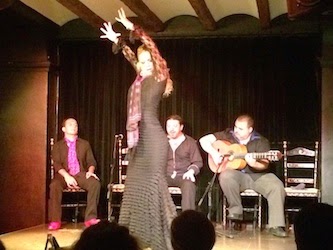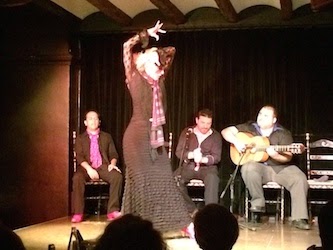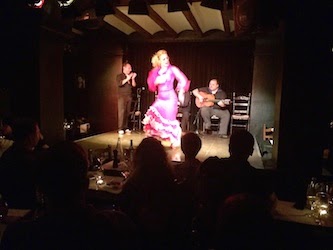They exchange glances, only for a moment, their eyes returning quickly, demurely to the floor. Their hands slowly raise over their heads, the heavy soles of their shoes beat out a rhythm increasingly more frenetic than the Spanish guitar and the distinctly Moorish vocals in the background, and they begin to turn, slowly at first, just enough that the frills of her dress begin to fan out in all directions.
The song becomes a mournful wail, overflowing with emotion and intensity. In response, they begin to move across the small floor, towards each other, and as they pass they spin around each other so quickly they disappear in a whirl of pink and black. They retreat to opposite sides, having exchanged places, the emotional moment of the music subsiding. They glance up at each other with a slight smile and begin again.

We enjoyed this most traditional of Spanish performances at Valencia’s La Bulería, a flamenco bar in the southeast quadrant of the city, ironically not very far from the ultra-modern City of Arts and Sciences. We had walked the dozen or so blocks from our apartment overlooking the bull fighting ring, so when we arrived for dinner at 9:00 we were ready for a pitcher of cold sangria. After a dinner of paella, and starting our second pitcher, the flamenco began at 11:00. When we left, well past midnight, Chuck observed, “We’ve been in Spain 3 weeks now, and I haven’t felt that we’ve truly experienced Spain until now.”
Know that we are dancers, albeit beginners and ballroom dancers at that. Before we left home, we joked to our friends at our Arthur Murray studio that Chuck was going to make Lori take flamenco lessons while in Spain. In truth, just a few blocks from La Bulería, we passed a flamenco school, and classes were in progress. Not having had enough time to take in a flamenco show in Madrid, we were pleased to find La Bulería shortly after arriving in Valencia, but while attending a performance made it onto our must-do list, Lori hasn’t yet volunteered to take that class. Yet.
The show starts with a guitar player and a vocalist. To say the music is Moorish is an understatement: for us–only able to speak enough Spanish to successfully order wine, beer, and tapas–the soulful, lilting, sometimes wailing lyrics seem indistinguishable at times from the call to prayer. But somehow, perhaps from the raw, powerful emotions of the dancers, we guess that the lyrics are much less religious in nature.


The great museums of Europe–the Louvre, the Tate, the Prado–are obligatory visits for travelers. But among our greatest memories from traveling in Europe are the performing arts. Our list of great travel memories include attending a chamber quartet’s performance in Venice and a piano concert in Rome. To that list we wholeheartedly add Flamenco in Spain.







